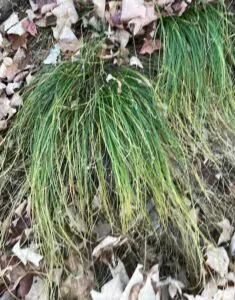Scuffing through the leaves in our woods, silent except for the crunching now that the stream is dry, I’m looking for the blades of sedge. According to my phone app, there’s a plaintain-leaved sedge (Carex plantaginea) and a white bear sedge (Carex albursina). White bear sedge is found on wooded slopes and plaintain-leaved sedge likes the wetter conditions around the stream and pond.
I spot a cluster of Pennsylvania sedge (Carex pensylvanica) around the roots of a northern red oak. It resembles fine-textured turf grass; its delicate seed heads have already been released. The plants are perennials of the forest floor and a solid addition to a woodland-style garden.
Sedges have been in the spotlight among gardeners and natural landscapers since the winter of 2023, when Mt. Cuba Center, the Delaware botanic garden focused on native species, released a four-year study. I love a good plant spreadsheet, and I’ve returned to the Mt. Cuba Carex database repeatedly while making selections for spaces.

Mt. Cuba has been sharing the results of its horticultural trials since 2003. It chooses popular and widely available species like phlox, asters and Echinacea, as well as under-utilized and less understood species like sedges. This winter it plans to share findings from trials on 20 bluestars (amsonia).
The trials track species over years and record observations about growth, qualities, adaptability, disease and pest resistance, among other factors, and ranks them on a scale of 1 to 5. With a huge diversity among sedges — there are hundreds of species in the Northeast alone — it can be challenging to know where to start as a gardener. There are volumes written on sedge identification and I’ve always been intimidated by the minute details needed to pin down a classification. Try Grasses, Sedges, Rushes: An Identification Guide, by Lauren Brown and Ted Elliman, if you want to join me in the quest.
Sedges are different from grasses in a few ways. The phrase goes something like: “Sedges have edges, rushes are round, grasses have nodes from the top to the ground.” Sedges have a triangle shape to the stem (hence “edges”), while grass stems are round. You can quickly know you’re looking at a sedge and not a grass by its lack of nodes, the joints you can feel along the stem where the leaf is attached.
Sedges can be the focus of a garden landscape, a ground cover, a lawn alternative or a lower layer in a planting. There are sedges that grow in full sun, part sun or shade, and in all types of soil and moisture conditions. Some are diminutive and others showier.
I’ve used Pennsylvania sedge on shady slopes to control erosion. It doesn’t need to be mowed. As a cool-season grass, it reaches full size in the spring. It spreads out through rhizomes but does so slowly. I plant plugs closely together to fill in space. A drawback about sedges is that they are not as easy to sow as seeds, nor are they readily available through commercial growers.
In the Mt. Cuba trial, the overall rating for sedge was 4.3 in shade and 4.2 in full sun, a top performer. The study also tested the cultivar Straw Hat, which got a slightly better rating for its straw-colored flowers in spring. The straight species has easy-to-miss seed heads instead of flowers.
The top performer in the trial was Wood’s sedge (Carex Woodii). There’s a lot of love for it, but last spring I found it hard to find from wholesalers. The fine textured foliage has a blueish tint and flowers in spring. Mt. Cuba noted that it was better at suppressing weeds than Pennsylvania sedge because the roots form a denser mat. Wood’s sedge, also sold commercially as Pretty Sedge, grew well in both sun and shade.
I’ve found multiple species of Carex at nurseries that focus on native plants but not often at other landscape centers. Pennsylvania sedge is the most frequently stocked. As is always the case, consumer demand can shift availability, so be sure to request a plant if you can’t find it.

